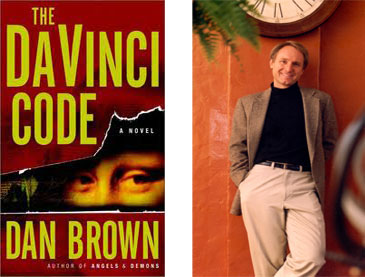Guest Expert: Laurel Marshfield
The Da Vinci Code Model
Around Christmastime, a number of years ago, I was browsing at a local Borders bookstore (now, sadly, extinct), looking for, among other things, thrillers by the mega-bestselling author, Dan Brown.
A client of mine wanted to construct his thriller-in-progress in the “Brownsian” manner, using densely applied historical research. Largely because — as he readily admitted — he was mesmerized by the fact that The Da Vinci Code was then enjoying headline-making sales. (It eventually sold 81 million copies worldwide, more than any other book in publishing history).

It was a special-edition Da Vinci Code, filled with photographs, illustrations, and pages of background material — all designed to lure readers into the dense forest of factual content the author had woven throughout his fictional world. Hmmm, I thought, interesting.
:: Nonfiction Can Promote Fiction?
Moments later, I asked myself this question: If “nonfiction” (in the form of historical research) could be used to make fiction far more substantive and, as a result, far more appealing . . . might not nonfiction benefit from the same approach?
How would that work, though? Nonfiction, after all, is already factual. So there’s not the same substance-adding benefit that novels acquire by marrying fact and fiction.
After several seconds spent mentally flailing around, this question appeared unsolvable, at that moment, so I turned it over to my subconscious — hoping that part of my mind would have more luck (as it almost always did).
:: Can Nonfiction Borrow from Business?
Several hours later, I was back in my office doing some online research, when I came across the words “white paper” three times in the space of ten minutes. Was my subconscious suggesting . . . ? And if it was, what would a white paper for a nonfiction book look like? My creative mind refused to comment. It was time for my planning mind to take over.
Picking up a pen (I had long ago realized that a pen in the hand is worth bushels of words on the page – words yielded up more easily than with a keyboard) these brief notes appeared:
• Premise: White papers for nonfiction “expertise” books = novel idea.
• Question: But what would a white paper for a nonfiction book look like – what would it focus on?
• Answer: It would focus on a book-specific problem and solution; in other words, the book’s core message heavily corroborated with research and illustrative scenarios (i.e., stories, case studies, client stories).
• Question: But how would white papers for nonfiction books be used?
• Answer: They would be used to excite interest in three core audiences: Readers looking for answers, if not solutions. Professional organizations or other groups whose memberships would be interested in a presentation about the white paper’s topic. And traditional, professional, and online media.
• More specifically: White papers would be used to promote an author-expert to media outlets. To attract author speaking engagements. To encourage referrals — if an author has a practice or business, or consults and conducts workshops. And to offer as an incentive for joining an author’s mailing list (“free white paper download with eNewsletter signup”).
:: White Papers Versus Other Book Promo Methods
Okay. But don’t standard promotional methods cover all that already? Take book excerpts — don’t they do the same thing? Good point. And the answer is yes. And no.
As a brief segment of a book’s larger message, an excerpt can’t perform the same function that a white paper can. Short-sample excerpts are designed to stimulate interest in a book — but they are not, as white papers are, a problem-solving offering that stands alone, apart from the book they are drawn from.
White papers are, in many ways, a unique “genre.” They function as providers of “nutritional content.” That is, they offer free information that their intended audiences need and want, content designed to nourish their interests.
What that means in actual practice is that white papers provide a solid overview of the challenge their audiences face, along with research-supported original material that suggests either a workable approach or an actual solution.
But, my conscious mind cautioned, Don’t authors already have lots of ways to promote their books and reach out to readers? As in: author websites, book trailers, social media – not just Twitter and Facebook, but book review sites, virtual book tours . . . Yes, that’s certainly true. White papers, though, reach out to a book’s potential readers in an entirely different way.
:: The “No-Sell” Promotional Strategy
Instead of promoting a book, white papers “promote” a problem the book’s potential audience wants a solution to. In other words, they offer readers content that can’t help but attract them to the author and his or her book.
This strategy is often called “attraction marketing.” And it works by not overtly selling readers anything (the author’s agenda), but instead attracting them by giving them what they want and need (the reader’s agenda).
It’s simply a matter of recognizing that, if readers see a given author as a source of content they value, they’ll naturally want more of that content. And they’ll buy the book.
For instance, let’s say a business coach has written an expertise book for small business owners about surviving and thriving in the Great Recession. A white paper on that topic is something the business media, business organizations, and business owners would find vital to their interests. Their “ears would perk up.” And if the white paper’s content is solid and actionable, then book sales would be the result.
:: A New Promotional Frontier?
White papers represent a new frontier because they are a not-yet “overcrowded” way to stand out from the clamoring crowd in a given subject area or field. Book excerpts, their closest promotional cousin, are standard on Amazon (through the “Look Inside” feature), but relatively few authors are exploiting the huge potential of white papers. This is true despite the fact that — not only do they offer lots of “attraction” potential unduplicated by other promotional methods — white papers (unlike excerpts) can be written for any audience an author wants to reach.
It seems just a matter of time before this leading promotional vehicle for business becomes the leading promotional vehicle for nonfiction expertise books, too.
:: Are White Papers for You?
Perhaps you’re starting to wonder if white papers could give you the content-promoting edge you’ve been looking for — by putting your book’s message into the hands of those who need and want it most?
There’s a painless way to find out.
To celebrate a year’s worth of BookBuzzr blog posts, I’d like to give you a grand finale New Year’s gift. It’s a free, hour-long phone consultation in which we’ll explore how white papers can put attraction marketing to work for your nonfiction book. This is a $155. value. But it’s available free of charge to the first three authors who mention BookBuzzr when filling out this Contact form: http://bit.ly/tTDjNZ
If you end up being number four or higher, don’t worry. You have another option. There are an unlimited number of free, fifteen-minute consults to explore how white papers would work for your book.
Happy New Year (it’s the perfect time to become a book promo pioneer)!
 Laurel Marshfield — refusing to run from a New Year’s resolution challenge — has taken seriously the pioneering potential of white papers for nonfiction expertise authors, and just launched a new offshoot business :: Blue Horizon White Papers.
Laurel Marshfield — refusing to run from a New Year’s resolution challenge — has taken seriously the pioneering potential of white papers for nonfiction expertise authors, and just launched a new offshoot business :: Blue Horizon White Papers.

It complements Blue Horizon Communications, her Editorial Services for Authors business.

For clients of both, Laurel’s three decades as a professional writer, developmental editor, and ghostwriter means they reap the benefit of long creative experience.
• At Blue Horizon Communications, Laurel helps authors shape, develop, and refine their book manuscripts, while providing: author consultation, manuscript evaluation, developmental editing, ghostwriting, collaboration, co-writing, book coaching, and related editorial services.
• At Blue Horizon White Papers, Laurel offers white paper production services for nonfiction authors (and professional service businesses) by providing: white paper development, ghostwriting, editing or updating (for existing papers), and white paper coaching. Her design professional business partner, Miki Schmidt of SchmidtADV, provides white paper formatting and graphic design.



